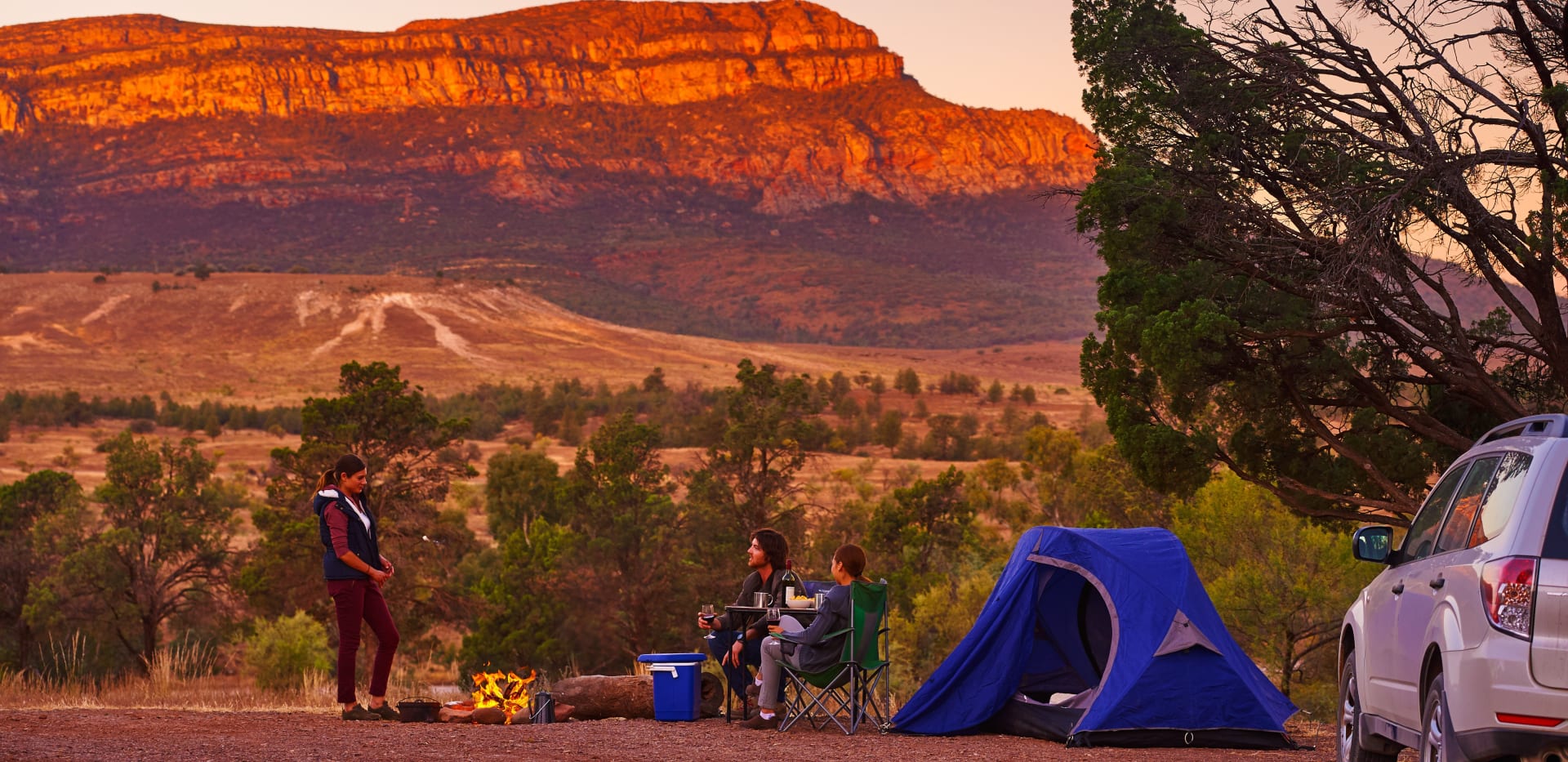Welcome to the Ultimate Family Camping Guide for Flinders Ranges!
Oh, happy day, adventurous families! Are you ready to sprinkle some extra magic into your family time? Then pack your tents, gather the kiddos, and let’s set forth on a journey to the majestic Flinders Ranges. With its rich Aboriginal history, diverse wildlife, and breathtaking scenery, camping in Australia’s outback will be a story to tell for years to come! And this guide? It’s your trusty compass pointing towards a holiday loaded with joy, exploration, and cherished family memories. So, buckle up as we navigate the ins and outs of camping in the spectacular Flinders Ranges!
Why Flinders Ranges is a Camping Wonderland for Families
What makes Flinders Ranges a dream destination for your family escapade? Imagine waking up to the soft glow of the sunrise, greeting you through the canvas of your tent. Mornings start with the songs of native birds, as you share a breakfast surrounded by the ancient, rugged landscape. The Flinders Ranges offers not just a camping trip but an experience steeped in natural beauty and deep cultural significance.
From the iconic Wilpena Pound to the fossil-rich Ediacara Conservation Park, every step you take is a step through the pages of Earth’s history book. And let’s not forget the activities! Whether it’s hiking the trails, spotting rare wildlife, or learning about the Adnyamathanha people’s traditions, Flinders Ranges truly has it all.
Planning Your Trip: What You Need to Know
Planning is the foundation of a blissful camping trip. Here are some quick tips to get you started:
- Best Time to Visit: The optimal time for camping in Flinders Ranges is during the cooler months, from April to October. Summer can be scorching, and many facilities may be closed.
- Choosing a Campsite: There are several family-friendly campsites within Flinders Ranges National Park. Book ahead to secure a spot in popular sites such as Wilpena Pound Resort Campground or Rawnsley Park Station.
- Packing Essentials: Prepare for varied temperatures – warm clothes for cool nights and lighter wear for daytime exploring. Don’t forget plenty of water, sun protection, sturdy walking shoes, and your sense of adventure!
With good planning, your trip will be off to a fabulous start. But wait! There’s more to unfold. We’ll guide you through creating an unforgettable itinerary, keeping the young ones entertained and safe, and all the practical know-how for a smooth outdoor escapade in Flinders Ranges. Shall we continue?
Creating Your Family-Friendly Itinerary in Flinders Ranges
Camping with kids means balancing adventure with simplicity and safety. When it comes to Flinders Ranges, there’s an abundance of sites and activities suitable for the whole gang. Trek through the Alligator Gorge, take a scenic drive to the Prairie Hotel for a unique outback dining experience, or learn about ancient geology at Bunyeroo and Brachina Gorges. There’s even the opportunity for a guided tour to learn about the area’s significant Aboriginal heritage.
Remember, when traveling with kids, flexibility is key. Plan for downtime too, where you can simply bask in the beauty of the natural surroundings, have a relaxing picnic, or play some family-friendly camping games.
Are you visualizing it all? The kids with their eyes wide in wonder as they discover the hidden treasures of Flinders Ranges? The laughter around the campfire as you exchange stories of the day’s adventures? Great! Now, let’s explore more on keeping everyone engaged and what to pack to enhance your Flinders Ranges camping adventure.
Stay tuned, dear campers! Our journey into preparing for the ultimate Flinders Ranges family camping trip has only just begun. Next up, we’ll discuss activities to delight your little explorers and tips to ensure their safety in the great outdoors.
So, take a deep breath of anticipation, and let’s continue planning your family’s remarkable nature retreat. Remember, every good campout begins with excited whispers and the rustle of maps – and this adventure is no exception!

Five Things Parents Should Know When Preparing for Camping in Flinders Ranges
Camping in the Flinders Ranges is an enriching experience that requires thoughtful preparation, especially when kids are part of the expedition. Below are five essential points to help parents prepare for this unforgettable outdoor odyssey.
1. Safety Comes First
When exploring the rugged terrains of Flinders Ranges, safety should be your top priority. Prepare a first aid kit tailored to the outdoor environment. Include items such as band-aids, antiseptic wipes, insect repellent, sunscreen, and any personal medication. It’s also wise to inform someone of your plans and expected return, given the remote nature of the Ranges.
2. Hydration is Key
Due to the arid climate, ensuring adequate hydration is crucial. Pack a variety of water containers and consider a portable water filter or purification tablets as backup. Encourage everyone to drink water regularly, even if they’re not thirsty, to prevent dehydration.
3. Respect the Wildlife and Environment
The Flinders Ranges is a sanctuary for many native species like kangaroos, emus, and wedge-tailed eagles. Teach your children about the fauna they may encounter and the importance of not disturbing the natural habitat. Also, practice “Leave No Trace” principles to preserve the beauty and ecological integrity of the area.
4. Prepare for the Climate
Ensure your family is prepared for the region’s climate, which includes cold nights and potentially hot days. Pack suitable sleeping bags, insulated pads, and clothing that can be layered. Sun hats, sunglasses, and high SPF sunscreen are must-haves during the day, while warm hats and gloves are your best friends at night.
5. Engagement and Education
Immerse your children in the rich history and geology of Flinders Ranges. Pre-trip, share information or watch documentaries about the area. Once there, engage with local guides and rangers who can offer educational talks that are both informative and entertaining. Foster a sense of wonder and discovery by involving kids in navigating maps and planning daily activities.
These foundational tips will help ensure that your camping experience is as smooth and enjoyable as possible. Remember, the best family adventures are the ones where everyone returns home with big smiles and bigger stories. So, gear up, get ready, and make the most of every sun-kissed moment and starlit night in the awe-inspiring Flinders Ranges.
With all this preparation in mind, the Flinders Ranges awaits your family’s footsteps, ready to unlock its ancient secrets and create new, joyful memories. Let’s continue delving deeper into what it takes to make your family camping trip a resounding success!
In subsequent sections of this guide, you’ll find information on some of the best child-friendly hikes, creative ways to document your journey (like journaling or nature photography), and tips for a comfortable sleep in the great outdoors. You will also discover the secrets to perfect campfire cooking and how to maintain an eco-friendly campsite for other adventurers to enjoy in the future.
Flinders Ranges is not just about where you go, but what you do and feel along the way. It’s an invitation for your family to bond, learn, and grow together against the backdrop of Australia’s rugged beauty. So, let those planning wheels turn, and get excited for an adventure that will echo in your family’s hearts long after the camping gear has been packed away.
Excited? Eager? Ready? We’re with you every step of the way as your journey unfolds. Let the countdown to your Flinders Ranges adventure begin, and watch as your family’s connection to nature and each other grows stronger with each shared sunrise and campfire story.
Adventure beckons, dear campers! Forge ahead, and let’s pave the way for an epic Flinders Ranges camping excursion that your family will reminisce about for a lifetime!
. For more information see here
Disclaimer
The articles available via our website provide general information only and we strongly urge readers to exercise caution and conduct their own thorough research and fact-checking. The information presented should not be taken as absolute truth, and, to the maximum extent permitted by law, we will not be held liable for any inaccuracies or errors in the content. It is essential for individuals to independently verify and validate the information before making any decisions or taking any actions based on the articles.




